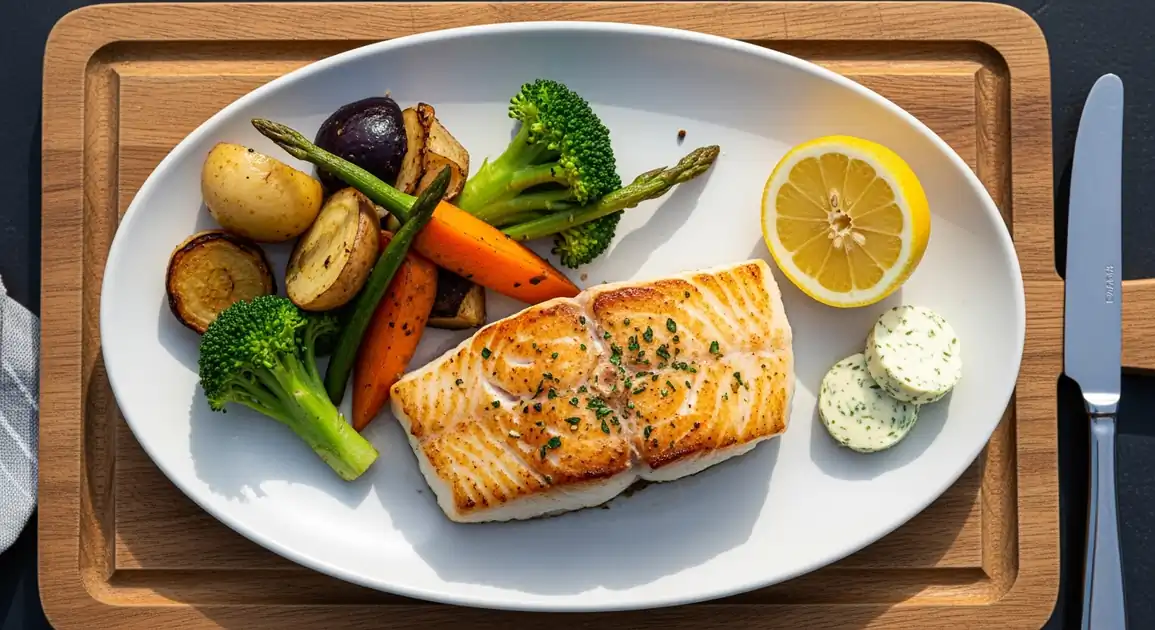Hapuku (New Zealand Groper)
Hapuku

Description
Throughout New Zealand, hapuku (groper) is regarded as one of the country's premier eating fish. While traditionally more abundant around the South Island, it's found in deep waters around both islands. New Zealand's strict fisheries management means hapuku is carefully harvested, making it a premium rather than everyday fish on most menus.
Dietary Information
Serving information
Serving style
Typically served as a main course in restaurants, presented on warmed plates with complementary New Zealand ingredients such as kumara (sweet potato), native herbs, or seasonal vegetables. Usually portioned as a generous fillet (180-220g).
Quick facts
Most seafood restaurants serve dinner from 5:30 PM - 10 PM. Fish markets typically operate from 7 AM - 5 PM, with the freshest selection early in the day.
Safety Tips
What to Look For
-
Clear, bright flesh with natural moisture
Quality hapuku fillets should have translucent, pearly white to slightly pink flesh that looks moist but not wet or slimy.
-
Firm texture that springs back when pressed
Fresh hapuku has firm flesh that rebounds when gently pressed with a finger—this indicates it hasn't begun to break down.
-
Clean, oceanic smell
Fresh hapuku should smell pleasantly of the ocean—never fishy, sour, or ammonia-like.
-
Establishment's reputation for seafood quality
Restaurants known for seafood expertise or markets with high turnover are more likely to serve fresh, properly handled hapuku.
-
Transparency about source and catch date
Quality vendors and restaurants will know and willingly share when and where their hapuku was caught.
What to avoid
-
Fish with a strong fishy or ammonia smell
Any strong unpleasant odor indicates decomposition has begun and the fish is not fresh.
-
Discolored flesh with browning edges or darkening
Discoloration suggests oxidation has occurred and the fish is aging.
-
Excessive liquid in packaged fillets
Too much liquid in packaging indicates cell breakdown and loss of texture and flavor.
-
Squishy texture that holds finger indentations
Fresh fish should be firm. If your finger leaves an indentation, the flesh has begun to degrade.
-
Bargain prices for "premium" hapuku
Hapuku is a premium fish with a price to match—suspiciously cheap hapuku may be mislabeled or of poor quality.
Price information
Price range
Budget tips
- Look for hapuku in specialized fish markets where prices may be better than at supermarkets.
- Consider trying hapuku at lunch rather than dinner service, when many restaurants offer the same dish at lower prices.
- Some restaurants offer hapuku as part of a seafood platter, which can be a more economical way to try it alongside other local fish.
Value indicators
- Specific mention of where the fish was caught.
- The term 'today's catch' or specific catch dates.
- Descriptions mentioning 'line-caught' or sustainable fishing methods.
- Restaurants that change their menu based on seasonal availability rather than always offering hapuku.
Where to Find This Dish
Coastal Restaurants
Restaurants along New Zealand's extensive coastline often feature hapuku, particularly in fishing ports and towns.
Harborfronts, Waterfront dining districts
Dinner (6 PM - 9 PM), Weekend lunch (12 PM - 2 PM)
Urban Fine Dining
High-end restaurants in major cities pride themselves on showcasing premium New Zealand seafood, including hapuku.
Central business districts, Hotel restaurants
Dinner (6 PM - 10 PM)
Fish Markets
Fresh fish markets in coastal towns and cities sometimes offer hapuku for home preparation.
Local fish markets, Farmers' markets with seafood vendors
Morning (7 AM - 11 AM), After fishing boats return (varies by location)
Vendor Tips
- Ask specifically when the hapuku was caught or delivered to the establishment.
- Request information about where the fish was sourced to ensure it's genuinely local.
- In restaurants, inquire whether the chef has any special preparation methods for hapuku that day.
How to Order
Regional Variations
-
Pan-seared Hapuku
(Pan-seared Hapuku)
The most common restaurant preparation—fillets are seasoned simply, then pan-seared with the skin on until crispy while keeping the flesh moist and tender.
-
Grilled Hapuku
(Grilled Hapuku)
Often prepared on an open flame or charcoal grill, highlighting the fish's robust texture while adding a slight smokiness.
-
Roasted Whole Hapuku
(Roasted Whole Hapuku)
Smaller specimens roasted whole, often with herbs stuffed in the cavity and served as a centerpiece for special occasions.
-
Hapuku Crudo
(Hapuku Crudo)
A contemporary preparation featuring raw, thinly sliced hapuku dressed with citrus, good olive oil, and sea salt, showcasing the fish's clean flavor.
-
Smoked Hapuku
(Smoked Hapuku)
Cold-smoked hapuku, often served as an appetizer with capers, lemon, and crackers or bread, though less common than other preparations.
Cultural context
History
Hapuku has long been valued by Māori, who traditionally caught these large fish in deeper waters using specialized techniques. Called "hāpuku" in te reo Māori, it was considered a prestigious catch due to its size and excellent eating qualities. European settlers quickly recognized its culinary value, and it became commercially important by the late 19th century. Today, hapuku remains a prized catch, though conservation measures now regulate its harvest as awareness of its slow growth rate and vulnerability to overfishing has increased.
Local significance
Hapuku represents New Zealand's exceptional seafood quality and the country's connection to its surrounding oceans. It exemplifies the 'kaimoana' (seafood) tradition that's important to both Māori culture and modern New Zealand cuisine.
Eating customs
- Typically enjoyed as a main course rather than an appetizer.
- Often paired with New Zealand white wines, particularly Chardonnay or Sauvignon Blanc.
- Usually served with seasonal local vegetables or native ingredients.